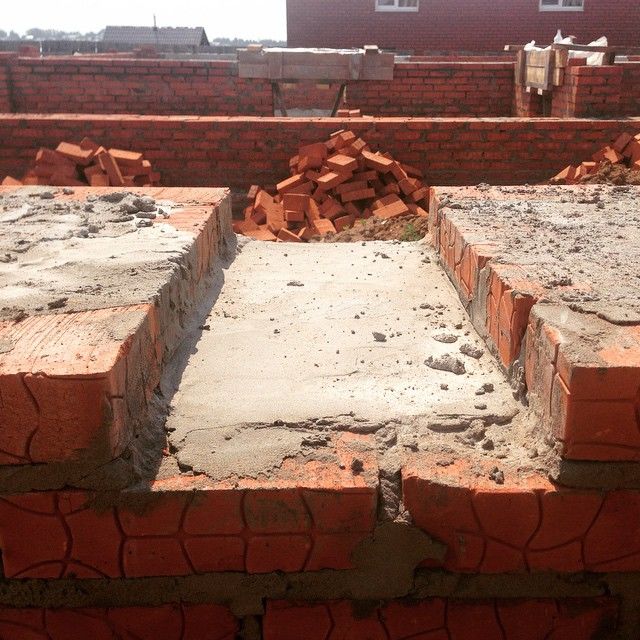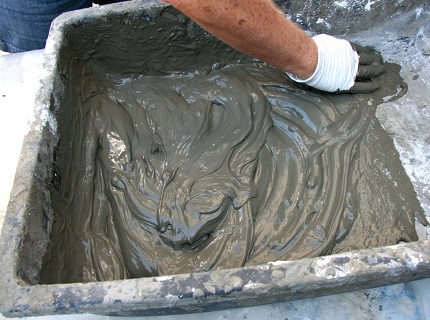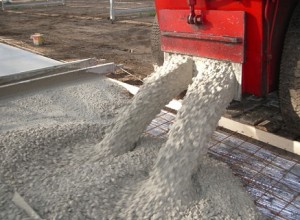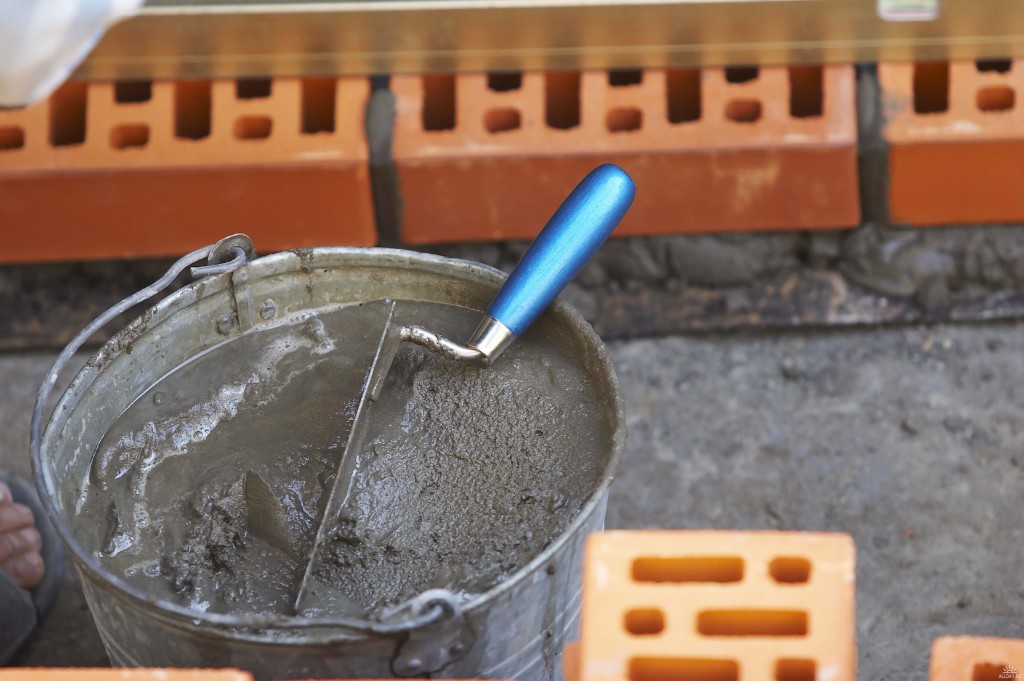The strength and durability of the structure depends on the qualitative characteristics of the cement mortar. Therefore, it is important to purchase all the necessary components for its preparation in advance. The calculation of the masonry solution is carried out on the basis of determining the consumption of cement, the hygroscopic properties of which require the accuracy and efficiency of the workpiece to avoid the unsuitability of the mixture.
The calculation of the brickwork solution depends on the project, the type of brick and the cement vintage affiliation. As a rule, a mixture is used to build walls of bricks, the hardness of which varies within the value of M50, M100.
Calculation scheme for brick masonry
Initially, the preparation of cement-sand essherence provides for the determination of its desired cement brand, the choice of which directly depends on the intended strength ready. Its class should be two, three times to exceed the hardness of the mixture. So, for obtaining a cement solution, the hardness of M100, it is necessary to purchase the cement of the vintage properties of M200 or M300. The most rational solution will be the use of the M400 brand. Its certain percentage in the preparation of the mixture allows to achieve the desired strength coefficient.
The next stage provides for the calculation of the amount of solution for masonry, which is determined based on the flow rate of 0.25 m3 per square meter. m. brick masonry.
As practice shows, for laying a wall, one brick thickness, 0.21 cubic meters will be required. Solid. The laying of two bricks involves the consumption of 0.23 m3 cement-sand mixture. It is important to take into account, regardless of the type of solution of the applied solution (standard three-component, lime or with an admixture of plasticizers), the volume flow will be the same. At the same time, the amount of mixture depends on the structural features of the brick. Hollow version of its variant will significantly increase the consumption of cement mortar.

The calculator for calculating the masonry solution will allow calculations relative to the total volume of the cement mixture. The accuracy of the result obtained is determined by the accuracy of the measurement of the size of the walls, window and door openings. The presence of concrete bees of the walls provides for the calculation of their height from the overall measurements.
To calculate, it is necessary to set the parameters of the length and height of the walls in meters, the thickness of the masonry, which is determined, based on the brick thickness.
The construction of the online calculator provides the possibility of a quick and convenient miscalculation of the value of the cement mortar. Among other things, the determination of the consumption of brick masonry will allow you to navigate in the value of masonry and launch the required budget to build construction.
Before starting any construction, you need to calculate the required amount of materials. Preliminary calculation greatly facilitates the entire process and makes it more organized, not spontaneous.
Preliminary calculation greatly facilitates the entire process and makes it more organized, not spontaneous.
Adhering to calculation as a plan of action, you will not only be able to control your expenses, but will also know exactly at what stage is your repair or construction.
With some kinds of materials, such as brick or metal tile, everything is more or less clear, and how to calculate the required amount of cement? Initially, it is necessary to determine which type of solution you need to get. The amount of binding substance, that is, the cement required in solution is regulated by the joint venture 82-101-98 and depends on its brand.
Types of solutions
- Heavy masonry. Such solutions include cement-limestone, cement-clay and cement-sandy. The cube of this type of solution requires from 90 to 429 kg of cement;
- Heavy finishing works. Such solutions are cement-sandy and cement-lime. In the first case, the cube accounts for 320-710 kg of cement, and in the second case, the cube leaves from 92 to 204 kg;
- Plastering and decorative based on marble crumbs. The number of cement on the cube is about 310 kg;
- Easy. It is a cement-lime mixture, about 210 kg of cement is consumed on one cube;
- Cerezite. It consists of 84 kg of binder, 0.12 cubic meters of sand and additives in the form of lime and mica.

Sand is best used in the so-called natural humidity, which is 3-7%.
Making calculation is also taken into account the water-cement ratio and the humidity of the sand. It is best to use the sand of the so-called natural humidity, which is 3-7%. Why do you need to be very careful with water? The fact is that the more its content, the less durable the solution will be. To harvest concrete, water requires only 20% of the mass of cement. But with such an amount of water, the solution is inconvenient to put and almost impossible to mix. It is necessary to add water, which, when frozen, will evaporate and form pores (emptiness). As a result, the strength of the frozen concrete will decrease.
Preparation of a solution of a certain brand

The basis of concrete-crushed stone and gravel.
Concrete is a common building material that consists of a substrate - rubble or gravel - and a binder element - a cement-sand mixture mixed on the water. From a correctly selected proportion of materials depends on its strength. Making it, you need to know that the calculation must be accurate, one cube should be carried out with an accuracy of 1 kg, and the rubble consumption is up to 5 kg. The smaller the volume of cement in the solution (coming per 1 cube concrete), the more dense and more reliable will be concrete.
If you meet a reference somewhere that it is necessary to obtain a certain solution, for example, two cement bags, then know that the word bags were used to facilitate perception. Prior to this, the desired amount of material was calculated with an accuracy of 1 kg and it turned out that the two bags contain it in a certain amount.

The optimal ratio in the gravel or rubble concrete is 0.8 cube, sand-0.5 cube.
So that the cement is spent economically, its brand should be higher than the brand of concrete you want to get in the end. Experts recommend calculating all components of parts. For example, 1: 5 is the designation that one volume of the binder requires 5 volumes of sand. If you are using the M600 brand, the proportions of the materials 1 to 3 should be observed, and if M400 is 1 to 2.
When the water is added to the solution, its volume decreases relative to the volume of the dry mixture. By producing a calculation, it is very important to take into account this fact and not to be mistaken, considering the required amount of cement, it must be multiplied by the coefficient of 1.3. Then you can correctly determine its quantity for the solution.
The optimal consistency of concrete is considered to be such in which the volume of gravel or rubble is 0.8 cube, and the sand is 0.5 cube. At the same time, determine how much cement is needed, it is possible on the basis of the proportion and multiplying the resulting digit to the coefficient. To monitor the correctness of the calculus, there are certain standards. For the most common brands of concrete, they look like this:
- M150 brand concrete - cement M300 - 510 kg; M400 - 400 kg; M500 - 330 kg;
- M200 - M400 - 490 kg; M500 - 410 kg;
- M300 - M400 - 600 kg; M500 - 510 kg.
Focusing on this data, you can prepare any solution that can only be required for a specific task. These norms are suitable for frozen and set the strength of the solution at normal temperature. To speed up the process, it is possible to increase the temperature around the object, in which case the solidification will be rapidly, but the strength will decrease. Under these conditions, it is possible to compensate for the lack of strength, initially increasing the amount of cement on average by 1/3. In compliance with all the above recommendations, it is possible to count on the strength and durability of the manufactured repair or built building.
Necessary consumption of cement mortar For various foundations
For the construction of the house (especially the fillings of the foundation) it is important to use high-quality concrete. Therefore, it is not worth saving on the cement. You can check its quality yourself.
First you need to make a test bar from that solution that is planned to be used for construction. Now it will take a chisel and a hammer (400 g). The chisel must be placed on the bar and heavily hit the hammer on it. If it bounced off the surface, it means that concrete brands M150-M200. If inclined to 5 mm - the M75-M100 solution brand, if the M75 is deeper below.
To calculate the necessary consumption of the solution on M 3 of the masonry, you need to know how much concrete need, and calculate the volume of the foundation. The brand of concrete will depend on the ratio of water and cement.
Formulas for calculating the calculation of the solution to 1M 3 will differ depending on the type of foundation (tape, column, slab). The volume of the plate is calculated by the formula: V \u003d SHH, where S is the plate area, H is its height. It should also be taken into account the ribs of rigidity and calculate their volume by the formula: V \u003d SHL, where S is the cross-sectional area, L is the length. The obtained indicators must be summed.
To calculate cement consumption for belt Fundament, It is necessary to use the formula: V \u003d SHL, where S is the length of the fill, L is the cross-sectional area. If the foundation is columnar, you need to calculate the number of supports (considering the weight of the structure) and their cross section. It is also important to consider the possible mass of the building content. The volume calculation will be calculated as follows: V \u003d SHHn, where n is the number of supports. For cylindrical columns, the cross section area :. According to this formula, the consumption of solution on the brick is calculated if the pillars are made from it.
Calculation of the amount of cement for filling the foundation
Concrete is made of several components: cement, water and substances for strength (pebbles, sand). It is important to know their exact proportions to obtain certain grades of the solution. The ratio is calculated by the formula: K \u003d V / C, where K is the coefficient, B - the volume of water, C - the mass of cement.
The coefficient of the watercraft ratio will depend on many factors, including from the presence of rubble in the solution. If it is not provided, it means, it is necessary to subtract 0.1 from the finished value.
Also, the factors affecting the desired amount of water are the magnitude of the fractions of the rubble used and the entire volume of the solution. Because of this, the required amount of water is calculated based on certain data.
To find high strength to the foundation, rubble in solution. If you take a substance with fractions 15 mm, then you will need 220 liters of water. If the house is provided under the house, the construction of the hopper and take the M600 cement, then taking into account the coefficient in / c, equal to 0.60, the volume of cement can be calculated (C \u003d B / 0.60). The result is C \u003d 366.67 kg. Now it remains to learn the proportions of fillers. If we take a recipe with indicators 1: 3: 5, then rubble need to be 366.67x5 \u003d 1833.35 kg, and sand 366,36x3 \u003d 1100 kg.
Here you can make the necessary calculations for making a solution for masonry with your own hands. Enter the desired number in the "solution volume" in the Count, select the brand and you will get accurate proportions of cement, sand and water. Construction solutions are prepared for different purposes, for example, for masonry walls of the house and masonry of the furnace walls, the preparation recipe is somewhat different. Be careful when calculating.
Bricks Masonry Solution
For many years, brick was used for the construction of walls, but the development construction technologies He led to the fact that new materials appeared on the market - blocks of gas or foam concrete, ceramic blocks, as well as blocks of foamed polystyrene. So that the walls of the building were durable and resistant to different atmospheric influences, for masonry different species building material Prepare different solutions. For this use construction mixes With cement, cement-limestone or lime base.
Cement mortar Apply to the construction of walls from concrete blocks, ordinary or clinker bricks. It is necessary to consider that the brand of such a masonry solution should not be above the class of strength of the material used to build walls. The solution should be plastic, easy to apply and do not drain from the wall. To ensure these qualities, plasticizers are added to the mixture, and in order for the solution to retain the waterproof of the seams, sealing additives add to it. It is especially good to use a cement solution for walls that are affected by atmospheric precipitation or are in a humid environment. It can be walls of the foundation or facade of the building, basement, chimney walls.
How to make a solution yourself?
To obtain a solution, cement is mixed with sand having an average fraction. To prepare the simplest mixture to 1 parts of the cement, 3-4 pieces of pure sacrificed river sand of the middle fraction are added. The dry composition is well stirred, and then the water is poured as long as the solution does not turn into a homogeneous mass with the necessary level of mobility. However, such a composition quickly freezes during masonry, therefore, clay or plasticizers add to it to increase plasticity and binding qualities. Such a solution is easier to align on the wall surface, it will provide a better seal, and the laying will look neatly. As a binding additives in the mixture, you can add a small amount of soap, detergents or washing powder.
Brand solutions for masonry
M25 solution. This is a cement mortar for brickwork or masonry of other types of stones. M25 solution brand, is its official and correct name, it is used both in special literature and in practice construction work. M25 solution refers to mixed (complex) solutions for masonry. The M25 cement solution consists of a filler for a solution, binder and water. The role of filler for the M25 solution usually plays ordinary sand. At the same time, the sand is cleaner, the higher the strength of the solution.
M50 solution. It is one of the most popular. It is mixed, complex mortar For masonry bricks and other types of stone, grid tie floors. M50 consists of a binder element, water and filler. The filler is a well purified sand from clay, which improves the strength of the cement mortar. The binding element is cement, water is used, naturally, also purified.
M-75 solution. The strength of the M75 cement solution depends on which proportions are mixed with sand with cement, as a binding component and water. M75 is a high brand solution, its proportion - 1 part of cement to 3 parts of sand and a little less than one part of the water. Therefore, it is plastic and durable than convenient to use. Cement mortar M75 is indispensable when mounting structures from a precast concrete, pouring aligning screeds, brickwork.
M-100 solution. The M100 cement mortar is used mainly when carrying out masonry and plastering, as well as in the manufacture cement screeds floors. The main difference between the solution M 100 from concrete similar brand is the absence of a large aggregate (rubble) in the composition of the mixture. Naturally, the composition itself is also different. A much larger content of cement and sand than in a similar brand concrete. The M-100 solution can also be called as: cement, construction, masonry, plastering solution.
What is needed for rapid solutions?
In order to increase the time of the composition of the composition during masonry prepare cement-limestone. To do this, lime dough add to the cement-sand mixture. First, 2/3 of the water is poured into the cooking container, then 1 part of cement and lime are poured, mixed at least 15 minutes well, then fasten the remaining water and 3 to 4 parts of the sand. Such a solution is also used to erect the walls of foam and aerated concrete, after adding special foam additives to it, which will increase the thermal insulation of the docking seams.
Lime-based solution enjoyed when erected inland walls or interior partitions. It is characterized by high plasticity, so the walls will look carefully. To prepare the solution mixed 1 part of the smallest lime with 3 to 5 parts of pure sainted sand, mixed to obtain a homogeneous dry mass, and then fill the desired amount of water. The solution should be homogeneous and not having lumps.
In the case of preparing a masonry solution, its composition depends on the quality of the components used, weather conditions, temperature fluctuations and is determined by the experimental way in each case.





